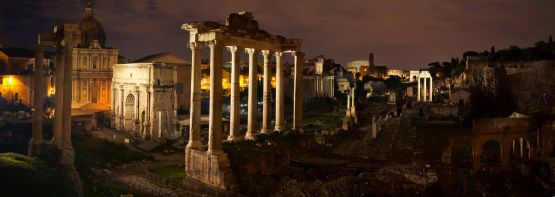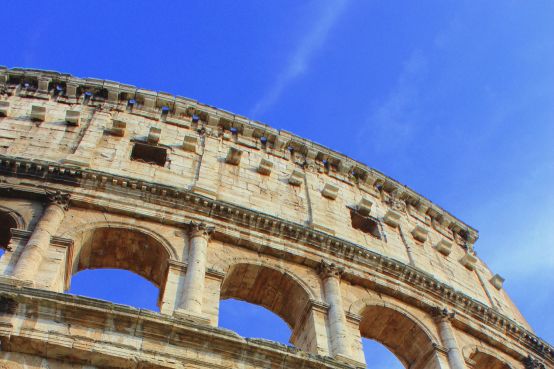Enjoy in-depth guided tours of the Colosseum to learn about theatrical games held in the famous Arena. You can choose from Rome walking tours concentrating on Ancient Rome or special Day Tours of Rome combining Ancient Rome with other attractions in the Eternal City.
The overheated atmosphere of the Amphitheatre Flavio (later named the Colosseum in Medieval Times) was intense. The head Ancient Roman Gladiator (lanista) acted as referee and quickly separated the opponents with his long pole. The sound of a trumpet interrupted the dual when one of the gladiators gravely hurt falls to the ground. The winner would show no remorse as he asked for grace with a ritual gesture (‘missio') from the organizer of the show (‘editor'), seated in the stand of honour. This encouraged the excited public to decide the destiny of the loser by a thumbs up or down gesture.
On a day when the public shows no mercy! A supreme referee (Caronte) a term that the Romans loaned from Greek mythology checks the immobile body and the mortal dual is finished. The body is dragged out of the Colosseum by a hook towards the door of executions (porta libitina). Spectators leave the arena happy from one of the 76 exits painted in vivid colours. And another days work for the Ancient Roman Gladiators is finished.
During the morning hours fighting of wild animals (venations ) took place in the arena, on top of one metre thick concrete foundations which were lain over Nero's lake (Domus Aurea). The basement of the Colosseum's arena was 6m deep, 75m long and 44m wide and was in the form of an underground ark that could have belonged to Noah. Wooden ramps lead down from the central corridor from which emerged the wild beasts when entering the arena.
Barred cages were found in the five narrow and half open lateral corridors. Small bridges and lifts led to the 62 wooden trapdoors inserted within the pavement of the arena, so that it seemed that the animals arrived by magic inside the arena. Stages operated mechanically by lifts allowed the Ancient Roman Gladiators to make a grand entrance into the arena.
At midday, Roman capital executions were carried out. At this time of day the rays of sunshine fell vertically across the oval opening of the heavy curtains that kept the spectators in the shade. The efficient protection from the sun thanks to an ingenious roof covering, the ‘velarium' (an enormous linen tarpaulin) hung by a system of ropes, winches and wooden poles. It took 1000 sailors of the imperial fleet to hoist the show up above the 70,000 spectators.
They were also responsible for sprinkling water and perfumed essences onto the crowds. The ceremony of throwing human remains to the animals wasn't actually done in a vulgar way, rather a cynical performance of reality theatre. Whilst the scenery represented antique myths and legends adding to the electric atmosphere. A prelude to the battles of the Ancient Roman Gladiators
The afternoon was dedicated to the Ancient Roman Gladiator battles (munera). They arrived from the gladiator school nearby that looked like a barracks (ludus magnus) through a tunnel which lead directly to the arena. The gladiators entered solemnly by the two reserved doors in front of the emperor's box, where they would greet the sovereign.
In the case of Caesar and Marco Aurelio, they often tired of the battles and preferred to leaf through official documents. At great request by the public, the show began with a series of fake armed fights (prolusion) while the real battle would be announced by a trumpeter.
Fighting was by singular as well as groups of Ancient Roman Gladiators with as many as 20 different types. ‘Essedarii' fought on small carts. ‘Samnites' were well known for their crested helmet with a visor, a short sword (gladius) and long rectangular shield. The ‘gallica' gladiators used a large shield and a long bladed sword.
The ‘Thraces ‘ or ‘Threces' gladiators wore a helmet and protected themselves with a square shield. Whereas the gladiator known as ‘Retiarius' used a net and pitch fork, signs of their fisherman association. The ‘secutor' had a helmet with very exaggerated crest, a short sword and shield and protected their arms and hands with a handle(manicae).
Between the beginning of the Ancient Roman Gladiator games (264 AC) and their abolition (404 DC) millions of people lost their lives in the Colosseum including numerous Christian martyrs. Before the opening of the Colosseum, these mortal games (ludi) took place within ‘Circo Massimo'.
During the republic, ambitious politicians used it for their electoral propaganda and people voted for those who organised the most extravagant show with famous gladiators. During the imperial era fighting of the gladiators degenerated into a show for the masses in the more than 170 arenas of the empire.









